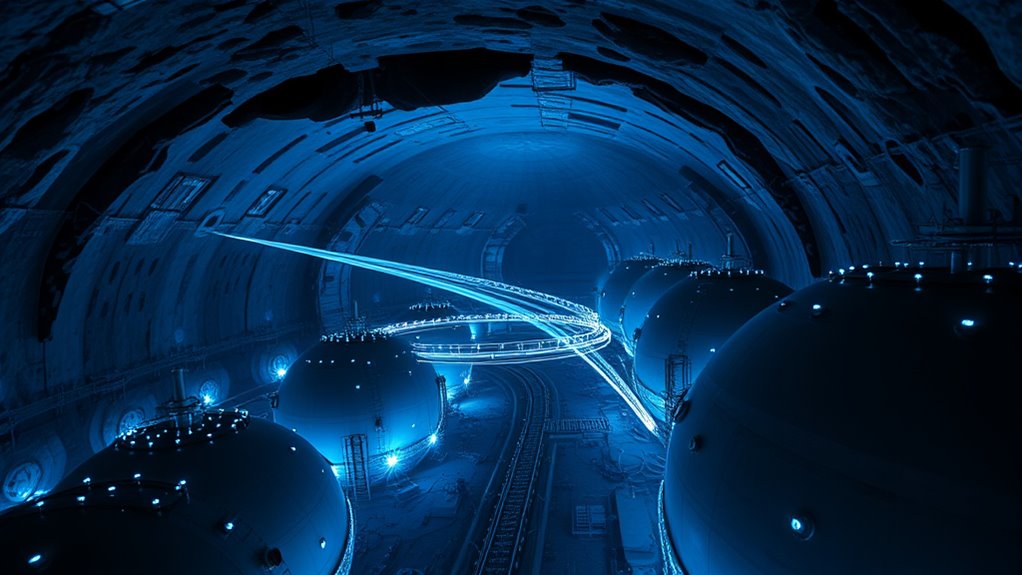Neutrinos are elusive particles that travel through space and matter almost unnoticed, yet they could hold the key to deciphering the universe’s biggest mysteries. By studying how they change identities, called neutrino oscillations, scientists learn about the fundamental properties of the universe, including its origins and structure. They might even reveal connections to dark matter, the universe’s hidden mass. Keep exploring to discover how these tiny particles could revolutionize our understanding of everything.
Key Takeaways
- Neutrinos are nearly massless particles that oscillate between types, revealing their hidden properties and challenging previous physics models.
- Studying neutrino oscillations provides insights into the universe’s matter-antimatter imbalance and early cosmic evolution.
- Neutrinos may interact with dark matter or originate from dark matter processes, offering indirect clues about this mysterious component.
- Exploring neutrinos helps unlock fundamental questions about the universe’s origin, structure, and the nature of its unseen elements.
- Neutrino research pushes scientific boundaries, potentially revealing profound truths about the universe’s hidden phenomena and fundamental laws.

Neutrinos are elusive particles that hold the key to some of the universe’s biggest mysteries. These tiny, nearly massless particles zip through space and matter with almost no interaction, making them incredibly difficult to detect. Yet, scientists have discovered that neutrinos are far from simple. One of their most fascinating behaviors is neutrino oscillations—an extraordinary phenomenon where neutrinos switch identities among three types or flavors as they travel. This discovery was groundbreaking because it proved neutrinos have mass, challenging the long-held belief that they were massless. Understanding neutrino oscillations isn’t just a matter of particle physics; it could reveal clues about the universe’s fundamental workings and its origins.
Neutrino oscillations reveal neutrinos have mass, unlocking secrets about the universe’s fundamental nature and origins.
Your quest to decode the universe’s secrets involves studying these oscillations in detail. By tracking how neutrinos change flavor over distance and time, scientists can gather crucial information about their properties and behavior. This knowledge could shed light on why the universe is composed mostly of matter rather than antimatter. It also helps refine models of how the universe evolved after the Big Bang, offering insights into the very fabric of reality. As you explore neutrino oscillations, you realize that they serve as a window into phenomena that are otherwise hidden, revealing subtle clues about the universe’s structure and history.
Another critical area where neutrinos could play a transformative role is in dark matter detection. Dark matter makes up about 27% of the universe’s mass-energy content, yet it remains invisible and mysterious. Traditional methods focus on observing its gravitational effects, but neutrinos might provide a new approach. Since some theories suggest that neutrinos could be linked to dark matter particles or that they might interact with dark matter under certain conditions, studying neutrinos could open pathways to identifying dark matter’s elusive nature. By detecting neutrinos produced by dark matter interactions or annihilations, you can gather indirect evidence of dark matter’s properties, bringing you closer to solving one of the most profound mysteries in cosmology.
As you piece together the puzzle of neutrino behavior—through oscillations and their potential connection to dark matter—you’re fundamentally opening a new chapter in understanding the universe. These tiny particles hold vast potential, not only answering questions about their own nature but also revealing secrets about the cosmos itself. Their study challenges current theories and pushes the boundaries of what you know about physics and the universe’s origin. With every discovery, you move closer to uncovering the profound truths hidden in the mysterious world of neutrinos.
Frequently Asked Questions
Can Neutrinos Travel Faster Than Light?
You might wonder if neutrinos can travel faster than light, making them superluminal particles. Current physics states that nothing with mass can surpass the speed of light, so neutrinos are believed to obey this limit. While some experiments hinted at faster-than-light travel, those results are often debated or retracted. So, based on what you know now, neutrinos don’t seem capable of superluminal travel, keeping Einstein’s theories intact.
What Is the Role of Neutrinos in Dark Matter?
You might wonder how neutrinos relate to dark matter. While they don’t make up most of it, their unique properties matter. Neutrino oscillations show they change types, hinting at mass. Scientists explore sterile neutrinos as possible dark matter candidates, though evidence isn’t conclusive. Your understanding of these particles helps reveal how they could influence the universe’s unseen mass, shaping galaxy formation and cosmic evolution.
How Do Neutrinos Influence Galaxy Formation?
Imagine neutrinos as cosmic messengers zooming through space at near-light speeds, shaping galaxies with invisible hands. Their oscillations influence galaxy clustering by subtly altering matter distribution. These tiny particles, though elusive, impact the gravitational framework that guides galaxy formation, acting as unseen architects. By understanding neutrino oscillations, you can grasp how they help form the universe’s grand cosmic web, weaving galaxies into the vast tapestry we observe today.
Are Neutrinos Responsible for Any Known Cosmic Phenomena?
You might wonder if neutrinos are behind any cosmic phenomena. They do influence the universe through processes like neutrino oscillations, which reveal their changing flavors, and the neutrino mass hierarchy, affecting how they behave in cosmic events. While they don’t cause phenomena directly, their subtle interactions help scientists understand cosmic events better, shedding light on the universe’s fundamental workings and potentially uncovering new physics.
Can Neutrinos Be Used for Communication Across Space?
You wonder if neutrinos can be used for cosmic communication. Because neutrino detection is highly advanced, you could send messages across space, bypassing obstacles like dust and darkness that hinder light signals. Their ability to travel vast distances without interference makes them ideal for cosmic communication. However, the challenge lies in detecting these elusive particles quickly and reliably, which is essential for practical use in interstellar messaging.
Conclusion
Neutrinos are truly elusive, making up about 85% of the universe’s matter despite being so hard to detect. Imagine that trillions pass through your body every second without you noticing! Unraveling their secrets could reveal the universe’s deepest mysteries, from how stars form to the nature of dark matter. So, keep an eye on neutrino research—you might just witness discoveries that reshape our understanding of everything around us.










